Garden railings,
Cocksedge & Co., Geo. Abbott
When the industrial revolution in this country was at its
height, cast iron was the marvellous new material for structures, The
Crystal Palace, home of the 1851 Great Exhbition in St James's Park,
London demonstrated that classical-style columns could be made, slim
and strong, out of cast iron to support mezzanine floors and roofs.
Plentiful iron ore, water and coal provided the raw materials and
labour was cheap. Relatively modest dwellings were adorned with cast
iron gates and railings to a set of standard designs – but what designs
they were. The story of how the government employed people during the
Second World War to cut out many of these features, supposedly to be
melted down for munitions, but probably dumped into the sea or rivers,
was probably a morale-boosting scheme to convince everyone that in
sacrificing their railings they were helping the war effort (see below).
Redan Street
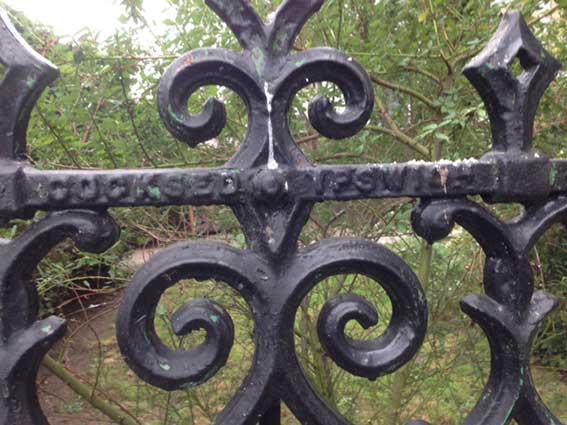 Photograph
courtesy Rachel Field
Photograph
courtesy Rachel Field
[UPDATE 7.10.2017: Above
– 'We were doing some clearing in our front garden this morning and
found this lettering on the iron railing between ourselves and our
neighbours' garden. We assume it says 'COCKSEDGE IPSWICH' and
that the railing escaped being collected in World War II. Best wishes,
Rachel Field (Redan Street).' Cocksedge
foundry in Rapier Street was a successful engineering firm, like their
larger neighbours, Ransomes & Rapier. However, not many traces of
their name are found in Ipswich. The above solid garden railing is an
excellent addition here; thanks Rachel. Incidentally, all sorts
of conspiracy theories can be found about the cutting-off and removal
of cast iron railings, gates and other objects from suburban gardens
during the last war. One school of thought says the iron
collected was unsuitable and could not be used; this seems unlikely as
recycled iron is a key component in the steel industry. Another more
likely explanation is that far more iron was collected – over one
millions tons by September 1944 – than was needed or could be
processed. Rather than halt the collection, which had turned out to be
a unifying effort for the country and of great propaganda value, the
government allowed it to continue. After the war, even when raw
materials were still in short supply, the widely held view is that the
government did not want to reveal that the sacrifice of so much highly
valued ironwork had been in vain and so it was quietly disposed of, or
even buried in landfill or at sea. One story has so much ironwork
dumped in the Thames estuary from barges that the metal affected
navigational devices on shipping.]
See another Cocksedge casting mark on the Island site page under 'Bollards'.
Salisbury Road
After this, we increasingly became aware that there might be
further
examples of lettered ironwork. Salisbury Road, home of the 'J.W. How' painted sign, has several
nice examples of railings dating to the building of the houses or
later. More than one gate bears the words:
'COCKSEDGE IPSWICH'
and, unexpectedly, one has:
'ABBOTT CROWN ST WORKS
IPSWICH'
in the casting.
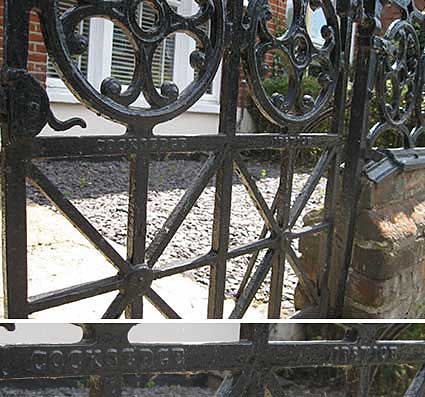
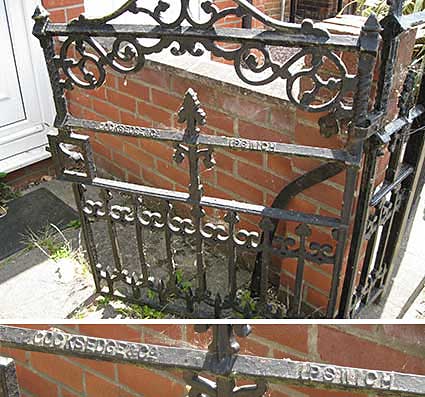
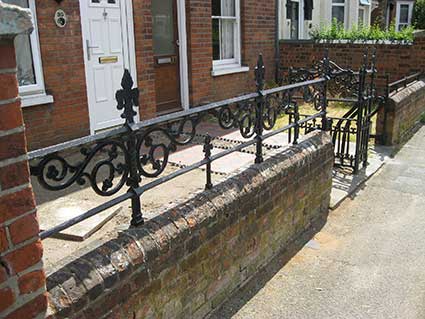 2018
images
2018
images
Above: Salisbury Road – two 'Cocksedge Ipswich' named gates and some
railings and gates with no obvious cast foundry name.
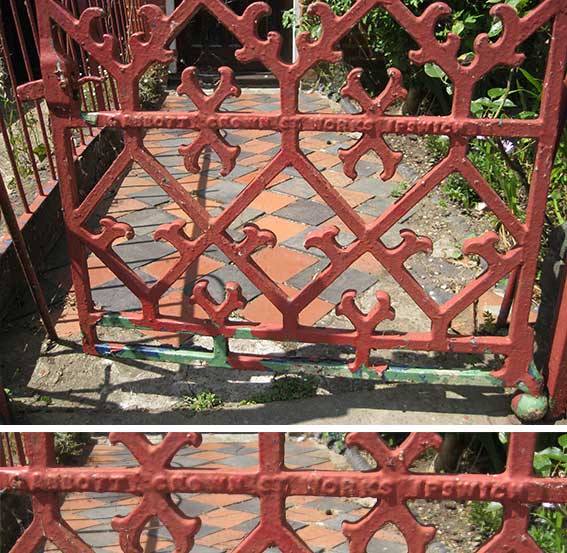 2018 images
2018 images
Above: quite a surprise to see this foundry recorded on one garden gate
in Salisbury Road, although we do know that Abbott's foundry in the old
Temperance Hall on Crown Street did make railings for gardens (see our 'More schools' page under Argyle Street
School for more information).
Mystery railings
‘I wondered if you could throw some light on my terrace railings that I
have recently restored. The intricate design was masked by what seemed
to be a layer of hardened putty, then primer then paint. John Norman of
the Ipswich Society, thought that they may have been cast at the
Temperance Works at the bottom of the High Street. The Records Office,
though cannot find any trace of it. I have enclosed a couple of
before and after pictures. I would dearly like to find out about the
company that made them. The lettering marks look to be 1862 - the house
is 1857. Kind regards, Sylvia Patsalides'
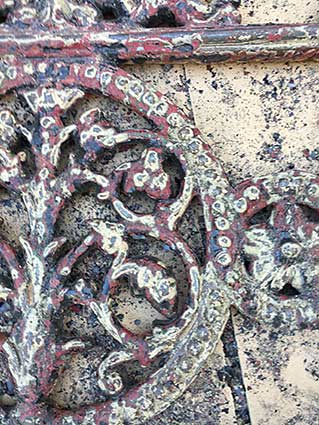
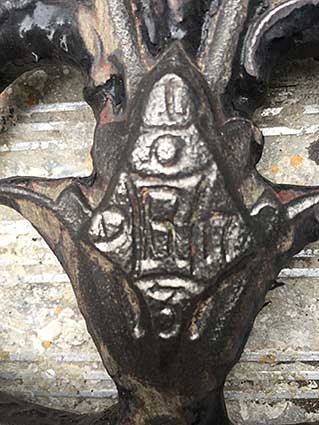 2017
photographs courtesy Sylvia Patsalides
2017
photographs courtesy Sylvia Patsalides
It took us a while to make out anything like a date. In fact, we can
see a figure ‘1’ at the top and a ‘3’ at the bottom of the boss;
reading across the centre, it might
be ‘1875’ (very small ‘5’?). Unless George Abbott had a
previous foundry, it seems unlikely that they were the source of
Sylvia's ironwork, as they only took over the Temperance Hall – quite a
change of function – in 1890 (see our More Schools page under 'Argyle Street
School' for more on Geo. Abbott's foundry). The other
foundry known to make railings
is Cocksedge, (see above) but the dates don’t marry up there either.
[See UPDATE below.]
Sylvia continues: ‘I haven't see any other railings like that in town -
the nearest is the insets in the Town Hall door… and a property in
Museum Street virtually opposite the Museum Street Café.’
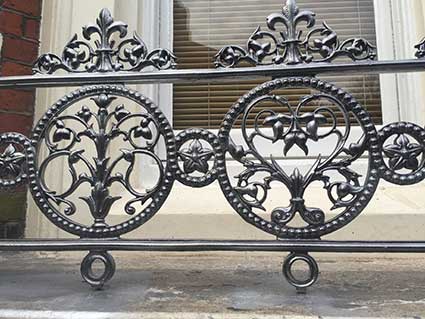
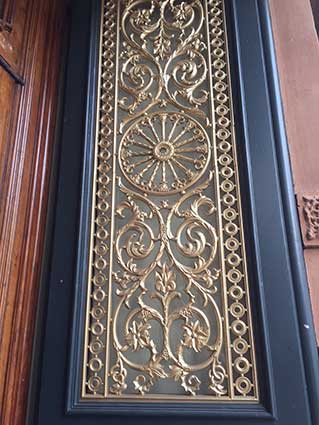 Town
Hall door
Town
Hall door
[UPDATE 7.11.2018: Syvia
Patsalides put us on to the solution to the diamond-shaped mark in her
railings:-]
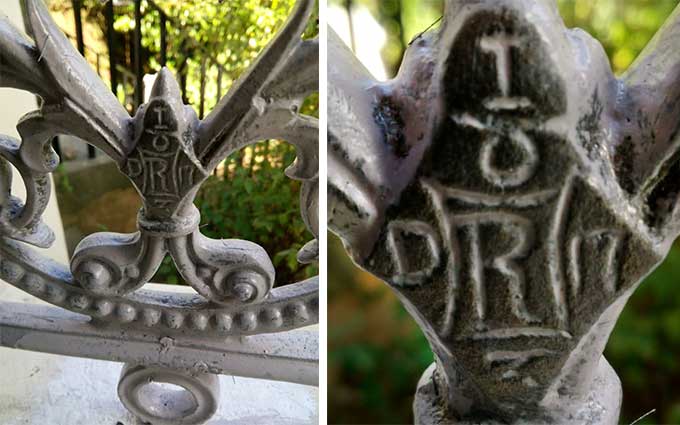 2018
photographs courtesy Sylvia Patsalides
2018
photographs courtesy Sylvia Patsalides
English Registry Marks
The diamond-shaped English Registry Mark, was used by the English
Patent Office since 1842 to identify products in metal, wood, glass,
ceramic, paper hangings, carpets, various textiles, furniture etc.).
The diamond design contains coded letters and numbers:
Registered. In the centre is,
usually, ‘Rd.’ indicating ‘Registered’, however, here it is just ‘R’
(which we assume is a natural truncation).
Material type. The Roman
numeral ‘I’ denotes metal, as here.
Year letter. A horizontal bar
separates the material number from a year letter: ‘O’ denotes 1862.
Marks registered from 1842 to 1867 have a letter; marks registered from
1867 to 1883 have a number instead of a letter.
Month letter. At the left of
the ‘R’ is September.
Day letter. At the right is 17;
so the date of manufacture is 17 September 1862.
Parcel number. Some conflicting
information here. At the bottom of the diamond is a ‘3’; this the
parcel number, which is (a) “is a code indicating the person or company
that registered the piece”, which would be handy, but we haven’t been
able to find a table of these; or (b) “You can ignore the number at the
bottom of the diamond - this tells us how many items were included in
the registration, (sometimes known as bundles or packages).”
So, one of the most interesting pieces of information, the
manufacturer/registerer, appears to be absent. As Sylvia points out:
'more intriguing – these stamps were changed everyday and obviously
have a specific meaning. It is looking to me like 17 September 1862 is
the date, but I am not sure how the find details of the bottom mark
(parcel), which will reveal the maker. How fascinating that in the
foundry, every day, someone was charged with the responsibility for the
date change . . . what stories were generated from those practices in
Victorian England. I have been to the Town Hall again and taken a
couple of pictures of the metalwork on the door but, looking closely,
whilst the design is similar the detail, is not as fine. I am intrigued
as to how these very fine railings are gracing my house. Glad that I
have made a contribution to the website. You have done so much work
over the years. It is fascinating.'
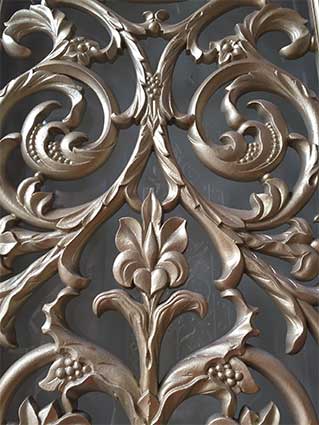 Town
Hall door detail
Town
Hall door detail
After 1883, the diamond shape was discontinued and "Rd. No.," followed
by the number assigned to the product, was used.
[Sources: https://www.kovels.com/identification-help/english-registry-marks.html;
https://www.925-1000.com/registry.html]
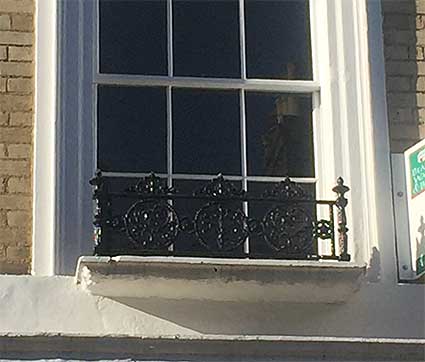 2018
images
2018
images
Sylvia writes: 'Above: 14 Museum Street. The railings look to be
exactly the same as those at Park House!'
Related pages:
For another example of a casting by Cocksedge, see our Dock ground level page under
'Bollards'.
For another example of railings by Geo. Abbott, see our More Schools page under 'Argyle Street
School'.
See our Castings page.
See also our Street furniture page.
Home
Please email any comments
and contributions by clicking here.
Search Ipswich
Historic Lettering
©2004
Copyright
throughout the Ipswich
Historic Lettering site: Borin Van Loon
No reproduction of text or images without express written permission

 Photograph
courtesy Rachel Field
Photograph
courtesy Rachel Field

 2018
images
2018
images 2018 images
2018 images
 2017
photographs courtesy Sylvia Patsalides
2017
photographs courtesy Sylvia Patsalides 
 Town
Hall door
Town
Hall door 2018
photographs courtesy Sylvia Patsalides
2018
photographs courtesy Sylvia Patsalides  Town
Hall door detail
Town
Hall door detail 2018
images
2018
images